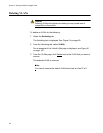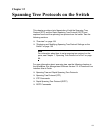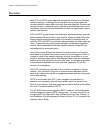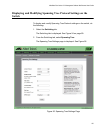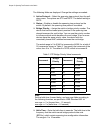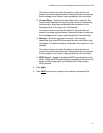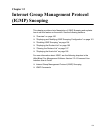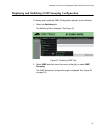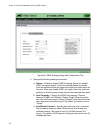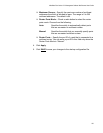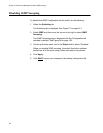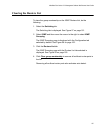
Chapter 13: Internet Group Management Protocol (IGMP) Snooping
160
Overview
IGMP snooping allows the switch to control the flow of multicast packets
from its ports. It enables the switch to forward packets of a multicast group
to only ports connected to members of the multicast group. When the
switch is not using IGMP snooping and receives multicast packets, it
floods the packets out all its ports, except the port on which it received the
packets. Such flooding of packets can negatively impact network
performance.
IGMP is used by IPv4 routers to create lists of nodes that are members of
multicast groups. A multicast group is a group of end nodes that want to
receive multicast packets from a multicast application. The router creates
a multicast membership list by periodically sending out queries to the local
area networks connected to its ports.
A node that wants to become a member of a multicast group responds to a
query by sending a report. A report indicates that an end node wants to
become a member of a multicast group. Nodes that join a multicast group
are referred to as host nodes. After joining a multicast group, a host node
must continue to periodically issue reports to remain a member.
After the router has received a report from a host node, it notes the
multicast group that the host node wants to join and the port on the router
where the node is located. Any multicast packets belonging to that
multicast group are then forwarded by the router from the port. If a
particular port on the router has no nodes that want to be members of
multicast groups, the router does not send multicast packets from the port.
This improves network performance by restricting the multicast packets
only to router ports where host nodes are located.
The switch monitors the flow of queries from routers and reports from host
nodes to build its own multicast membership lists. It uses the lists to
forward multicast packets to only switch ports where there are host nodes
that are members of multicast groups. This improves switch performance
and network security by restricting the flow of multicast packets to only
those switch ports that are connected to host nodes.
The switch maintains its list of multicast groups through an adjustable
timeout value, which controls how frequently it expects to see reports from
end nodes that want to remain members of multicast groups, and by
processing leave requests.
Note
When IGMP snooping is disabled on the switch, all reports are
suppressed on a port. The default setting for IGMP snooping on the
switch is disabled.



